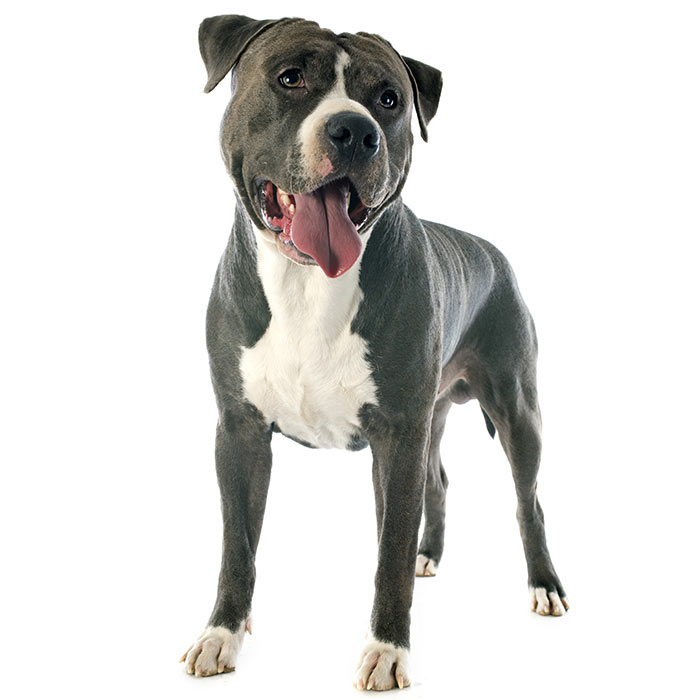Tibetan Mastiff


| Recommended for | Experienced owners and families with older children |
| Breed Classification | Working group |
| Other names | Do-Kyi, TM |
| Lifespan | 10 to 13 years |
| Size | Large to giant |
| Temperament | Protective, independent, loyal |
| Intelligence | Above average |
| Tendency to bark | High |
| Maintenance Level | Medium |
| Health Risk | High probability of health issues during its lifetime, hence it is one of the more expensive breeds to insure. |
Insuring a Tibetan Mastiff?
Get our award-winning Nose-to-Tail Cover with up to $30k annual benefit limit, up to 90% of eligible vet bills back, and no sub-limits.
Get a quick quote
Is this breed right for you?
Try our breed selector quiz to find out your best matching breed!
Insuring a Tibetan Mastiff?
Get our award-winning Nose-to-Tail Cover with up to $30k annual benefit limit, up to 90% of eligible vet bills back, and no sub-limits.
Get a quick quote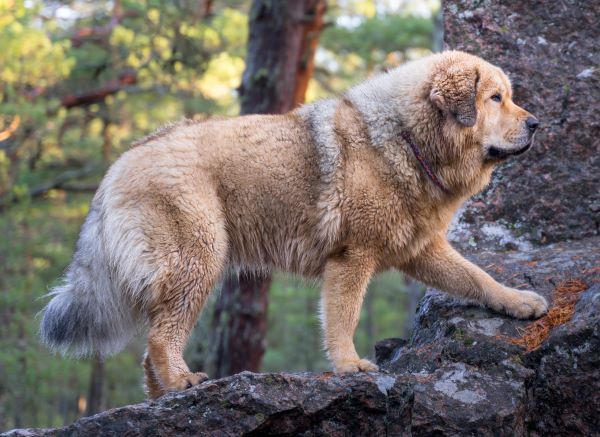
Breed history of Tibetan Mastiffs
Tibetan Mastiffs are one of the world’s oldest and most primitive dog breeds, with a history dating back thousands of years. Earliest accounts of the breed date back to the 12th century B.C. in China. Isolated from Western breeds, it developed into a unique animal that was highly prized by the people of the high Himalayan Mountains and plains of Central Asia.
The Tibetan Mastiff is known in Tibet as the Do-Kyi, which translates to “tied dog,” as they were tied at the gates of the homes and temples they guarded. Originally these dogs were used to protect Buddhist monasteries and monks from animals such as bears, wolves and snow leopards. Some believe that Tibetan Mastiffs have the souls of monks and nuns who did not make it into Shambhala, the heavenly paradise.
While there are no accurate records of the genetic heritage of the breed, Tibetan mastiffs are considered by many to be the basic stock from which most modern large working-breeds developed, including all mastiff or Molosser breeds and all mountain dogs.
The first Tibetan Mastiff pair were imported into Australia in early 1983, with a second female arriving shortly thereafter. These three dogs formed the strong basis of the Tibetan Mastiff breed in Australia.

Physical description of Tibetan Mastiffs
Tibetan Mastiffs are large, rugged, imposing and powerful dogs with a solemn expression and a dignified presence. Marco Polo described them as being as large as a small donkey, and their size alone is a deterrent to potential threats.
The breed developed to be able to withstand very cold temperatures, high altitudes and snow, and is ill-suited to hot or humid climates. The attractive double coat is comprised of a wooly undercoat and a medium to long outercoat of thick, bristly hair that comes in a wide variety of colours, sometimes with white markings around the neck, chest and legs. The coat is denser around the neck and shoulders and resembles a lion’s mane, more noticeably in males. The medium to long, bushy tail curls over the back to one side.
Tibetan Mastiffs typically mature slower than other breeds, with the males maturing at around the age of 4 to 5 years and the females at around 3 to 4 years.
| Weight range | Males 41 to 68 kg; females 34 to 54 kg |
| Height range | Males 66 cm; females 61 cm |
| Colours | Solid black, black & tan, shades of red, bluish-grey |
| Coat length | Medium to long |

Tibetan Mastiff personality and temperament
The large guardian dog of Tibet evolved over thousands of years to protect its territory, including its home (or tent), family, flock and herd. While some can be friendly, the breed is known to be aloof with strangers and fiercely loyal and protective of their loved ones. They bond very closely with their owners and are very personable, patient and gentle with them.
Tibetan Mastiffs are notorious for being a nocturnal sentry, keeping would-be predators and intruders at bay, and barking their deep, booming bark at unidentified sounds throughout the night. Much more laid back and fairly quiet when indoors, they often sleep during the day, making them more active, alert and aware during the later part of the day and in the early morning hours.
While they often prefer to be outdoors where they can view and patrol their territory, leaving them outside all night is not recommended, especially if there are neighbours nearby who will undoubtedly complain about the barking. A six-foot fence is required around the property to contain them; they are amazingly agile for their size and are skilled climbers and jumpers.
Definitely not the breed for novice dog owners, they require a confident owner who can show them, through absolute consistency, who is in charge. For such a strong-willed and dominant dog, ongoing socialisation, supervision and control are required to prevent excessive suspiciousness or aggression toward other people and animals.
Tibetan Mastiffs with kids and other pets
The Tibetan Mastiff is suitable for families with older children, but is too large to safely spend much time around younger kids, who could easily be knocked over or stepped on. Also, the noise and activity of young kids can excite the dog, who’s simply too big to be allowed to chase children or play roughly with them. While typically patient with their own children, they require careful introduction to those outside the family. They may feel the need to protect “their” children from other kids, especially if they’re wrestling or otherwise appear to be fighting.
Tibetan Mastiffs were bred to keep strange animals away from their flock and property. However, it’s possible that they can get along with other pets if appropriately socialised when very young. Their temperament is such that they may become aggressive with dogs of the same sex, even in their own family, and some won’t tolerate the opposite sex either. Many have strong instincts to chase and seize cats and other fleeing creatures.
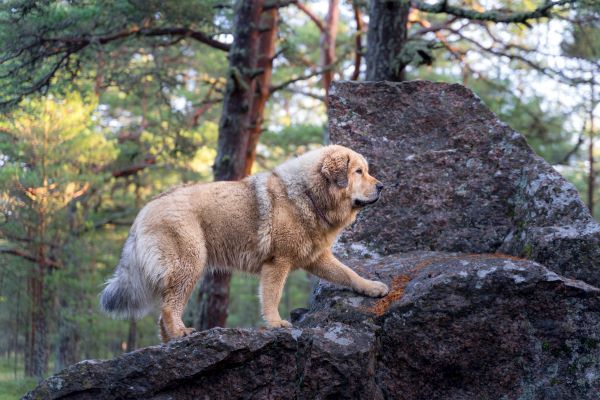
Tibetan Mastiff training and exercise
Tibetan Mastiffs love the great outdoors, especially in cold climates, and need plenty of room to romp. A large, securely fenced yard where they can run and have play sessions off-lead with their owner is essential. However, with their serious nature and guarding instincts, they might prefer to patrol the house to make sure that everything’s in order than to play fetch, frisbee or other games.
These enormous dogs tend to conserve their energy to be used in short bursts and refrain from activities that require endurance. Their exercise requirements can be met with a few 20 to 30 minutes of play in the yard or a couple of half-hour walks each day, except in hot or humid weather, as they can overheat.
Tibetan Mastiffs are very strong-willed and at times can be stubborn. This makes obedience training essential but challenging. Early socialisation is critical because of their guarding instincts and their reserve towards strangers. Owners should be experienced in handling large dogs, have an understand of canine psychology and be able and willing to spend a lot of time and devotion to training their dog. It’s recommended to keep them on a lead when you go out as they may not listen to your commands.
| Energy level | Medium |
| Exercise requirements | Moderate |
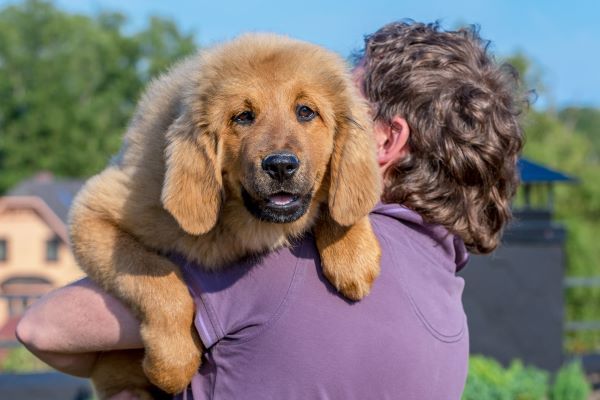
Tibetan Mastiff feeding and nutrition
The Tibetan Mastiff should be fed a premium, high-quality dog food appropriate to the dog’s age (puppy, adult, or senior), size and activity level.
They tend to eat only when hungry, and much less than you would expect for a dog of this size – adult Tibetan Mastiffs eat around 2 to 4 cups of dog food a day, and may even skip meals.
Tibetan Mastiffs that aren’t sufficiently exercised may become overweight, so watch your dog’s calorie consumption and weight level and don’t overindulge in the treats department. They usually don’t need any special diet, but check with your vet if you have any concerns about your Tibetan Mastiff’s weight or general health.
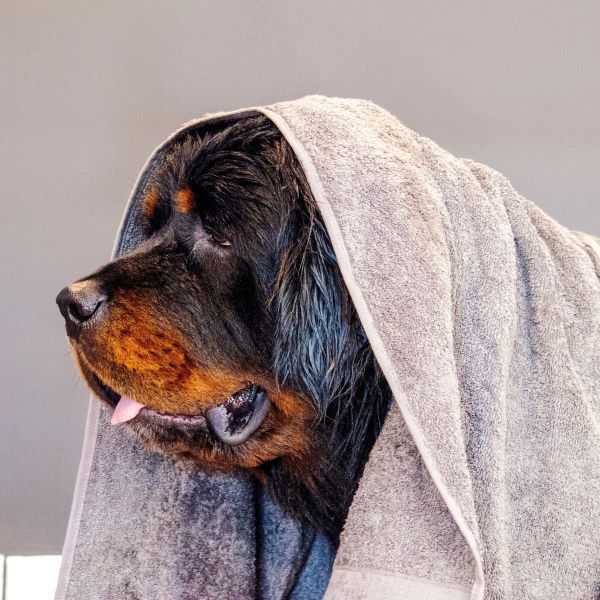
Tibetan Mastiff care and grooming
During shedding season Tibetan Mastiffs shed a lot. They usually have one great moult in late winter or early spring and sometimes another, lesser moult in the late summer or early autumn. While shedding, an undercoat rake or a de-shedding tool should take care of any loose hair.
Outside of shedding season, they don’t need much grooming apart from a weekly brushing using a slicker, pin brush or wide-tooth comb to get rid of any dirt and knots, particularly in the mane, breeches and tail where the coat is heaviest.
Some Tibetan Mastiffs, especially those with loose jowls, tend to slobber or drool, especially after eating and drinking. The coat of a Tibetan Mastiff doesn’t carry the unpleasant big-dog smell that affects many large breeds, so doesn’t usually require bathing more than once a month.
Health issues for Tibetan Mastiffs
- Hypothyroidism is a condition where the thyroid gland doesn’t produce enough hormones. It can lead to weight gain, skin issues and lethargy. Hypothyroidism is fairly common in Tibetan Mastiffs, as it is in many large “northern” breeds.
- Hip Dysplasia is a hereditary condition in which the hip joint doesn’t develop as it should, often leading to arthritis, prolonged limping and eventually lameness in later life.
 Elbow dysplasia, similarly to hip dysplasia, is a developmental problem affecting the elbow joint. It can cause lameness and discomfort.
Elbow dysplasia, similarly to hip dysplasia, is a developmental problem affecting the elbow joint. It can cause lameness and discomfort.- Canine Inherited Demyelinative Neuropathy (CIDN) is an inherited condition that may found in Tibetan Mastiff puppies by the time they are six weeks of age. The condition affects the nervous system and causes weakness in the rear legs that eventually progresses to complete paralysis. There is no treatment, but selective breeding has greatly reduced the incidence of this condition.
- Eye conditions that can occur in Tibetan Mastiffs include Progressive Retinal Atrophy and cataracts. Symptoms may include cloudiness, redness and blindness. As a result of their genetic makeup and facial anatomy, Tibetan Mastiffs may be susceptible to entropion and ectropion. Entropion is when the eyelid rolls inward, potentially causing eyelashes to irritate the cornea. Ectropion is when the eyelid turns outward, leading to possible eye irritation.
- Skin Allergies are fairly common in Tibetan Mastiffs and regular bathing may be required.
Not all conditions are covered by Pet Insurance. For details of Bow Wow Meow Pet Insurance cover, refer to the Product Disclosure Statement.
Free engraved pet ID tag on sign up3
Customer Satisfaction
21 day cooling off
Easy to use Pet Portal




